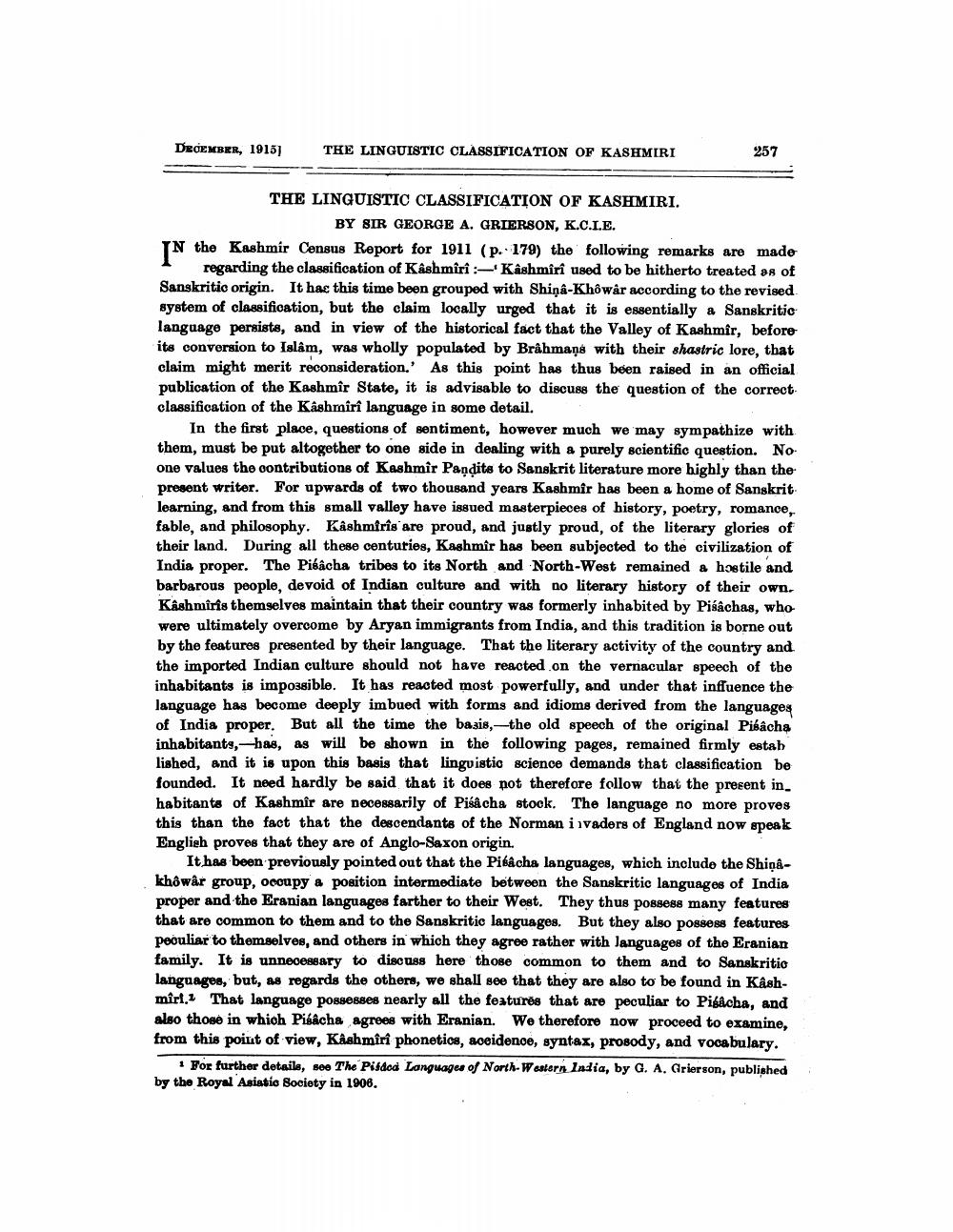________________
DECEMBER, 1915)
THE LINGUISTIC CLASSIFICATION OF KASHMIRI
257
THE LINGUISTIC CLASSIFICATION OF KASHMIRI.
BY SIR GEORGE A. GRIERSON, K.C.L.E. IN the Kashmir Census Report for 1911 (p. 179) the following remarks are made
regarding the classification of Kashmiri Kashmirî used to be hitherto treated as of Sanskritic origin. It has this time been grouped with Shiņa-Khôwâr according to the revised system of classification, but the claim locally urged that it is essentially & Sanskritic language persists, and in view of the historical fact that the Valley of Kashmir, before its conversion to Islâm, was wholly populated by Brâhmans with their shastric lore, that claim might merit reconsideration. As this point has thus been raised in an official publication of the Kashmîr State, it is advisable to discuss the question of the correct. classification of the Kashmirî language in some detail.
In the first place, questions of sentiment, however much we may sympathize with them, must be put altogether to one side in dealing with a purely scientific question. No one values the contributions of Kashmir Pandits to Sanskrit literature more highly than the present writer. For upwards of two thousand years Kashmir has been a home of Sanskrit learning, and from this small valley have issued masterpieces of history, poetry, romance, fable, and philosophy. Kashmîrîs are proud, and justly proud, of the literary glories of their land. During all these centuries, Kashmir has been subjected to the civilization of India proper. The Pibâcha tribes to its North and North-West remained a hostile and barbarous people, devoid of Indian culture and with no literary history of their own. Kashmiris themselves maintain that their country was formerly inhabited by Piśâchas, who were ultimately overcome by Aryan immigrants from India, and this tradition is borne out by the features presented by their language. That the literary activity of the country and the imported Indian culture should not have reacted on the vernacular speech of the inhabitants is impossible. It has reacted most powerfully, and under that influence the language has become deeply imbued with forms and idioms derived from the languages of India proper. But all the time the basis,-the old speech of the original Pibâcha inhabitants, has, as will be shown in the following pages, remained firmly estab lished, and it is upon this basis that linguistic science demands that classification be founded. It need hardly be said that it does not therefore follow that the present in. habitants of Kashmir are necessarily of Pisa cha stook. The language no more proves this than the fact that the descendants of the Norman invaders of England now speak Englieh proves that they are of Anglo-Saxon origin.
It has been previously pointed out that the Pifâcha languages, which include the Shiņakhôwâr group, occupy a position intermediate between the Sanskritic languages of India proper and the Eranian languages farther to their West. They thus possess many features that are common to them and to the Sanskritic languages. But they also possess features peculiar to themselves, and others in which they agree rather with languages of the Eranian family. It is unnecessary to discuss here those common to them and to Sanskritio languages, but, as regards the others, we shall see that they are also to be found in Kashmîrt. That language possesses nearly all the features that are peculiar to Pigacha, and also those in which Pisacha agrees with Eranian. We therefore now proceed to examine, from this point of view, Kashmirî phonetics, aceidenoe, syntax, prosody, and vocabulary.
For further details, so The Pildod Languages of North-Western India, by G. A. Grierson, published by the Royal Asiatic Society in 1908.




